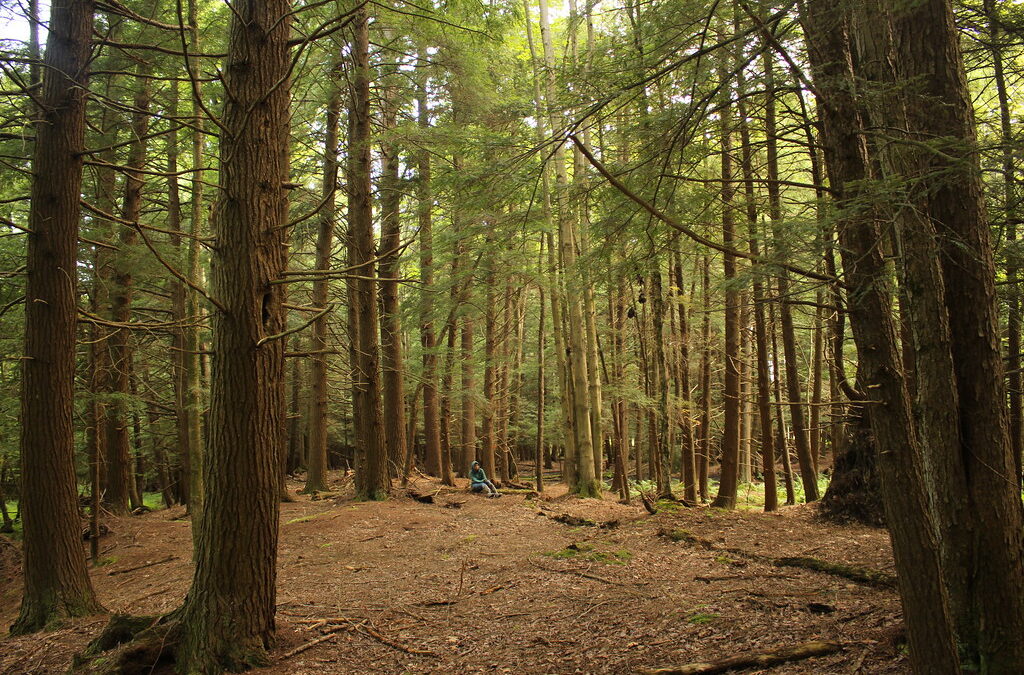By Chelsea Jandreau, Nature Educator
The snow hasn’t stuck around for very long lately, but the blustering winds remain strong. Wind, of all speeds and coming from any direction, can affect all living things, but when it enters gale warning territory, trees get the most attention, and for a good reason. High winds result in branches and sometimes entire trees falling over. This can be a safety hazard to people, houses and power lines, causing disruption to our daily life.
However, even lighter to moderate winds can affect the growth and longevity of trees and other plants over time. There are any number of quotes and passages about bending so you do not break. Frequently, this refers to a person’s resilience in terms of challenges or adversity they may face. Many trees rely on this philosophy in a somewhat more literal sense to physically survive the storms, especially those with high winds, that pass through.
Sometimes trees grow in a certain area because people planted them there, but many trees survive where they do because they are best suited to a certain set of conditions. When encountering an obstacle, wind is forced to change its speed, force and direction. If this obstacle happens to be the edge of a forest, those trees are forced to grow with a higher elasticity in order to survive. Trees further in the forest that have greater protection from wind do not necessarily get hit from the side, but are blown around by wind careening over the tree tops. This may cause those trees to grow with a slightly different flexibility and shape.
The wind often blows west to east. Many trees are used to wind coming from the same general direction, so both their trunk and roots grow accordingly. When the wind suddenly changes direction, this increases the chance that the tree will break. That being said, while there are trees that suffer in storms, there are certain trees that naturally do better in windy conditions. For example, palm trees are far more likely to survive the high winds of a hurricane because they are so flexible. They bend and sway with the wind, rather than cracking and breaking in half.

As with many things in science, there is a long, multisyllabic word to describe this phenomenon. Thigmomorphogenesis is the reaction of an organism to mechanical or physical contact, in this case, trees being the organism and wind the physical pressure. Although this series of complex changes is all happening at the molecular level, it might be more obvious to the average person than expected.
This is because, as with many scientific processes, you do not have to know the exact term or understand the chemicals involved to observe this situation in nature. If you have spent time wandering through a forest, you may have observed plants affected by this process. Maybe it is a deer trail where the plants have stopped growing over the path because the deer have simply walked and brushed by the brush so often that the branches start growing in a different direction. People also use this principle to train plants to grow in a certain shape or direction in order to create bonsai trees.
With all of these considerations, it may seem like wind is purely a damaging force for trees. However, mild winds are actually beneficial to trees and other plants. This movement increases their resiliency and creates a stronger overall plant. The absence of little stressors can eventually lead to a plant that breaks more easily or even falls over, unable to support its increasing size and weight. The same thing happens if you were to start a plant inside and then move it outdoors. It needs support at first and time for the chemical reactions inside the plant cells to strengthen the stem before it can stand on its own without breaking.
As is true with many things in nature, a little bit of resiliency goes a long way. Although the loss of a branch may be a difficulty for us when it lands directly on a power line, as long as the trunk remains standing and the roots are in the ground, the tree still has a chance of continued survival. Trees are living, growing things that respond to the world around them just as much as any animal or human being does.
Audubon Community Nature Center builds and nurtures connections between people and nature. ACNC is located just east of Route 62 between Warren and Jamestown. The trails are open from dawn to dusk and birds of prey can be viewed anytime the trails are open. The Nature Center is open from 10 a.m. until 4:30 p.m. daily except Sunday when it opens at 1 p.m. More information can be found online at auduboncnc.org or by calling (716) 569-2345.


Recent Comments